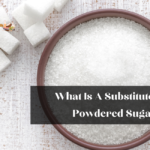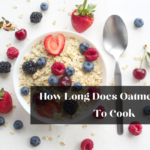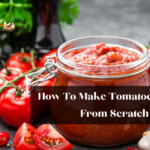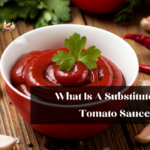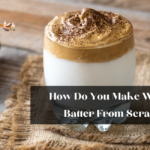If you need a substitute for powdered sugar (also known as confectioners’ sugar or icing sugar) in a recipe, there are several options you can consider, depending on the purpose of the sugar in the recipe. Keep in mind that these substitutions may not work perfectly in all recipes, as powdered sugar serves both a sweetening and textural purpose. This article, will explain what is a substitute for powdered sugar.
What Is A Substitute For Powdered Sugar
1. Granulated Sugar And Cornstarch
Combining granulated sugar and cornstarch is the easiest and most effective way to replace powdered sugar, since these two ingredients make up most of powdered sugar sold in stores.
Blend 1 tablespoon of cornstarch with 1 cup of powdered sugar in a high-powered blender (such as a Nutribullet or Vitamix) until the mixture is thin and powdery. Be tolerant! It may take several minutes to obtain the desired chalky texture. If you need a powerful blender, a coffee or spice grinder will suffice. However, due to their small size, it may be time-consuming and untidy.
2. Granulated Sugar And Potato Starch
If you don’t have any cornstarch on hand, you can substitute granulated sugar and potato starch. Potato starch is produced by removing the starch from potatoes. The starch is rinsed and desiccated to produce a fine white powder.
Like cornstarch, potato starch can be used as an anti-caking agent and thickener in similar applications. And since it is essentially flavorless, it will not alter the flavor of your favorite dishes. Additionally, it is (obviously) corn-free, making it an excellent option for those with corn allergies or those seeking to keep Passover kosher.
3. Granulated Sugar And Tapioca Starch
In addition to cornstarch, tapioca starch is an excellent ingredient for producing powdered sugar at home. Organic powdered sugar sold in stores frequently substitutes tapioca starch for cornstarch because cornstarch often does not meet organic standards.
This ubiquitous starch is produced by extracting the starch from cassava root (also known as yucca). This South American tuber is a staple food in Africa, Asia, and South America. The cassava root is pulverized to extract a starchy liquid; the water evaporates, leaving a powdery starch similar to cornstarch or potato starch.
4. Granulated Sugar And Arrowroot Powder
If you have arrowroot powder on hand, you can use it like cornstarch, potato starch, and tapioca starch by combining it with granulated sugar to create a suitable substitute for powdered sugar. Arrowroot starch is derived from the rhizomes, or underground stems, of the perennial vegetation Maranta arundinacea, which is native to the world’s rainforests.
This white, flavorless starch is traditionally used as a remedy for digestive disorders and a thickener for puddings, jellies, and pies. It is also an excellent anti-clumping agent for handmade powdered sugar.
5. Coconut Sugar And Starch Of Your Choice
Whether out of granulated sugar or searching for a less-processed form of powdered sugar, coconut sugar is an excellent substitute when combined with common starches such as cornstarch, arrowroot, tapioca, or potato. Coconut sugar is extracted from the juice of the coconut palm tree and coconut flowers.
6. Turbinado Sugar And Starch Of Your Choice
When mixed with one of the most common carbohydrates, raw turbinado sugar, which is a lightly processed form of cane sugar, can be used in place of powdered sugar. Because turbinado sugar isn’t processed as much as white sugar, it keeps a small amount of the natural molasses in sugarcane.
This gives it a light brown color and a caramel taste that isn’t quite the same as white sugar. Also, its big, crunchy crystals are great for topping banana bread or cinnamon cakes with.
7. Monk Fruit Sweetener And Starch Of Your Choice
Use a combination of monk fruit sweetener and starch, such as potato, corn, tapioca, or arrowroot, if you’re searching for a keto-friendly or calorie-free alternative to powdered sugar.
Monk fruit sweetener is derived from the Chinese gourd-like fruit native to the monk fruit plant, which contains mogrosides (via Scientific Reports). These mogrosides provide a high level of sweetness without the calories or glucose spike that cane sugar causes.
8. Splenda And The Starch Of Your Choice
When combined with one of the previously mentioned carbohydrates, powdered Splenda can serve as an excellent sugar-free substitute for powdered sugar, much like monk fruit sweetener. Splenda is composed of maltodextrin (a white powder derived from maize, potato, or rice starch) and sucralose and is available in powdered and granulated forms.
Because it lacks the bitter aftertaste of other artificial sweeteners, it’s a preferred substitute for sugary candies and treats. Its powdery consistency is ideal for sprinkling and dusting over delicacies where powdered sugar is typically used.
9. Stevia And The Starch Of Your Choice
When this common coffee sweetener is ground up and mixed with some starch, it makes a second good powdered sugar replacement. Stevia has no calories or carbohydrates, so it is a great choice for people who want to cut down on carbs or control their blood sugar.
Stevia, like Splenda, is significantly sweeter than sugar, so you will need to use less to obtain the same level of sweetness. Avoid using this substitute in recipes that require an exact quantity of powdered sugar, such as cookies, cakes, and meringues. Instead, use it for dusting desserts or supplementing sugar in a batch of buttercream frosting.
10. Dry Milk Powder
Dry milk powder is an unsung champion in the baking world. This pantry essential can flavor various dishes and baked products, including those that call for powdered sugar.
Milk powder is a shelf-stable, highly concentrated form of milk. Because it contains all of the milk’s fat, protein, and flavor, it enhances the richness and creaminess of various desserts. Its powdery texture allows it to be quickly dusted over pastries and cakes or even added to buttercream frosting to add bulk without sugar’s added sweetness and calories.
With these alternatives, you can confidently continue with your culinary endeavors in the absence of powdered sugar.
Thanks for reading.

